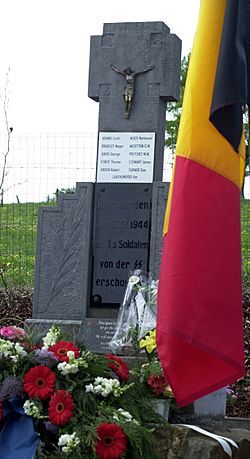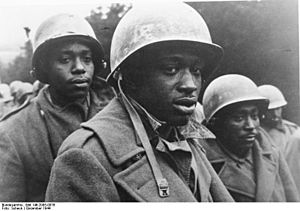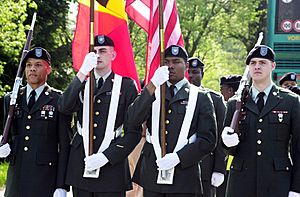333rd Field Artillery Battalion (United States) facts for kids
Quick facts for kids 333rd Field Artillery Battalion |
|
|---|---|

Memorial to the Wereth 11
|
|
| Active | 9 March 1943-10 June 1945 |
| Allegiance | United States |
| Branch | United States Army |
| Type | Field artillery |
| Size | Battalion |
| Motto(s) | Three Rounds |
| Colors | Red |
| Engagements |
World War II
|
The 333rd Field Artillery Battalion was a special unit in the United States Army during World War II. It was made up of African-American soldiers. At that time, the U.S. military was still segregated, meaning Black and white soldiers served in separate units.
This unit arrived in Normandy, France, in July 1944. They fought continuously as part of the army's artillery. In October 1944, they moved to Schoenberg, Belgium. During the famous Battle of the Bulge in December 1944, the unit was attacked by German troops. Most of the 333rd Battalion moved back. But two of their groups, Service and C Batteries, stayed behind. They covered the retreat of another American division. The unit suffered many losses. Tragically, 11 men from the 333rd were killed near a small Belgian village called Wereth.
After World War II, the battalion was closed down and then restarted several times. This happened during different army changes.
Contents
World War II: A Key Role
During World War II, it was common for segregated units to have white officers leading Black soldiers. On August 5, 1942, the 333rd Field Artillery Regiment was officially started. It was a segregated unit at Camp Gruber, Oklahoma. It became part of the U.S. Third Army. Later, on March 10, 1943, the regiment was reorganized. It split into the 333rd Field Artillery Group and two battalions: the 333rd Field Artillery Battalion and the 969th Field Artillery Battalion.
The 333rd Battalion landed in Normandy, France, in early July 1944. They went to Brittany and helped in the siege of Brest in August and September. After that, they fought their way across northern France. They then arrived in the Ardennes area, supporting the U.S. VIII Corps.
The Battle of the Bulge
The unit arrived in Schönberg, a small village near St. Vith, Belgium, in October. The Service Battery was west of the Our River. Batteries A, B, and C were east of the river. They were there to support the VII Corps. The 333rd Field Artillery Group and the 969th used large 155mm howitzers. Another unit, the 771st Field Artillery Battalion, used 4.5-inch guns. They first supported the 2nd Infantry Division. Then they supported the 106th Infantry Division.
When the Battle of the Bulge began, the unit was about 11 miles behind the front lines. In the early morning of December 16, German artillery started shelling the Schönberg area. By the afternoon, reports came in of fast German attacks. The 333rd Field Artillery Battalion was told to move further west. But the 106th Infantry Division's artillery commander asked Battery C and Service Battery to stay. They were needed to support the 14th Cavalry Regiment and the 106th Division.
By the morning of December 17, the Germans had captured Schönberg. They controlled the bridge connecting to St. Vith. Service Battery tried to move through the village to St. Vith. But they were hit by heavy German fire from armored vehicles and small guns. Many soldiers were killed. Those who remained were captured. As the captured soldiers were being moved, an American aircraft attacked the column. By the end of the day, the battalion had only five howitzers left. The rest were left behind during the retreat. The remaining soldiers of the 333rd Field Artillery Battalion were ordered to Bastogne. There, they joined the 969th Field Artillery Battalion. Both battalions helped the 101st Airborne Division during the Siege of Bastogne. For their bravery, they received the Presidential Unit Citation. This is the Army's highest award for a unit.
The Wereth 11 Massacre
50°20′55.14″N 6°13′55.37″E / 50.3486500°N 6.2320472°E
During the chaos of the battle, 11 men from the 333rd escaped into the woods. They were on the east side of the river. They tried to sneak north-west, hoping to reach American lines. Around 3 p.m., they came to the first house in Wereth, Belgium. It belonged to Mathias Langer. Mr. Langer offered them shelter. This area had been part of Germany for a long time. After World War I, it became part of Belgium. Three families in the village were still loyal to Germany. The wife of a German soldier in Wereth told members of the 1st SS Panzer Division that American soldiers were hiding there.
The SS troops quickly captured the Americans. The soldiers surrendered without fighting. The SS men then marched their prisoners to a nearby field. There, they were beaten, tortured, and then killed. As prisoners of war, these American soldiers should have been protected. This protection is part of the Geneva Convention, which Germany had agreed to follow. So, this cruel treatment and killing without a trial was a war crime.
The frozen bodies of the soldiers were found six weeks later. This was after the Allies took back the area. The SS troops had badly damaged the soldiers' faces. They had broken their legs with rifle butts. Some had their fingers cut off. Others were stabbed with bayonets. At least one soldier was shot while trying to help a wounded friend.
Today, research shows that the SS men responsible were from a scouting group. This group was led by Sturmbannführer Gustav Knittel. In 1946, Knittel was sentenced to life in prison. This was for ordering illegal killings of American prisoners during the Battle of the Bulge. His sentence was later reduced. He was released from prison in 1953.
The Wereth 11 Soldiers
Here are the names of the soldiers who were killed:
| Rank | Name | From | Service number | Buried | Awards |
|---|---|---|---|---|---|
| Staff Sergeant (Mess sergeant) | Forte, Thomas J. | Jackson, Mississippi | 34046992 | Henri-Chapelle plot C, row 11, grave 55. | Purple Heart |
| Technician Fourth Grade | Pritchett, William Edward | Camden, Alabama | 34552760 | McCaskill Cemetery, Wilcox County, Alabama | Purple Heart |
| Technician Fourth Grade | Stewart, James Aubrey | Piedmont, West Virginia | 35744547 | Henri-Chapelle, plot C, row 11, grave 2 | Purple Heart |
| Corporal | Bradley, Mager | Bolivar County, Mississippi | 34046336 | Fort Gibson National Cemetery, Fort Gibson, Oklahoma, plot 6, 0, 2698-E | Purple Heart |
| Private First Class | Davis, George | Jefferson County, Alabama | 34553436 | Henri-Chapelle, plot D, row 10, grave 61 | Purple Heart |
| Private First Class | Leatherwood, James Lee | Pontotoc, Mississippi | 34481753 | College Hill Cemetery, Pontotoc County, Mississippi, Plot C Row 9 Grave 57 | Purple Heart |
| Private First Class | Moten, George Washington | Hopkins County, Texas | 38304695 | Henri-Chapelle, plot E, row 10, grave 29 | Purple Heart |
| Private First Class | Turner, Due William | Emerson, Arkansas | 38383369 | Henri-Chapelle, plot F, row 5, grave 9 | Purple Heart |
| Private (medic) | Adams, Curtis | South Carolina | 34511454 | Henri-Chapelle, plot C, row 11, grave 41 | Purple Heart |
| Technician Fifth Grade | Green, Robert Leroy | Upson County, Georgia | 34552457 | Highland Park Cemetery, Highland Hills, Ohio, Section 3, Lot 3, Tier 24, Grave 22 | Purple Heart |
| Private | Moss, Nathaniel | Longview, Texas | 38040062 | Henri-Chapelle, plot F, row 10, grave 8 | Purple Heart |
Memorials to the Wereth 11
On September 11, 1994, Hermann Langer built a small stone cross. He was the son of Mathias Langer, who had tried to help the soldiers. This cross was to remember the 11 men who were killed. On May 23, 2004, a new memorial was built at the site of the killings. It honors the 11 soldiers and all African-American soldiers who fought in Europe. It is believed to be the only memorial in Europe specifically for African-American soldiers of World War II.
In 2006, a group from Worcester, Massachusetts, dedicated the first memorial to the Wereth 11 in the United States. It was placed at the Winchendon Veterans' Memorial Cemetery on August 20. In 2016, another memorial was put up in Miller Park, Bloomington, Illinois. Each soldier's name is on it.
The War's End
The 333rd Field Artillery Battalion suffered more losses than any other artillery unit in the VIII Corps during the Battle of the Bulge. Six officers, including the battalion commander, and 222 enlisted men were either killed or captured. They also lost many weapons and vehicles. The remaining 286 men were mostly sent to other battalions. The 333rd Field Artillery Group continued to serve in the Rhineland and Central Europe campaigns until the war ended.
After World War II
The 333rd Field Artillery Battalion was officially closed on June 10, 1945, in Germany. The 333rd Field Artillery Group was closed on December 30, 1945, in Camp Patrick Henry, Virginia. Both the 333rd and 969th Field Artillery Battalions were later restarted. The 333rd Field Artillery Battalion was renamed the 446th Field Artillery Battalion. On July 1, 1959, the 333rd Field Artillery Group was restarted as the 333rd Field Artillery Regiment. The 446th and 969th Battalions were then part of it.
On September 1, 1971, the regiment was renamed the 333rd Field Artillery Regiment. Four of its batteries served in Operation Desert Storm in 1991. Today, only one battery still carries the number 333rd Field Artillery. It is F TAB, 333rd FAR, stationed at Camp Casey, Korea. It is part of the 210th Field Artillery Brigade.



